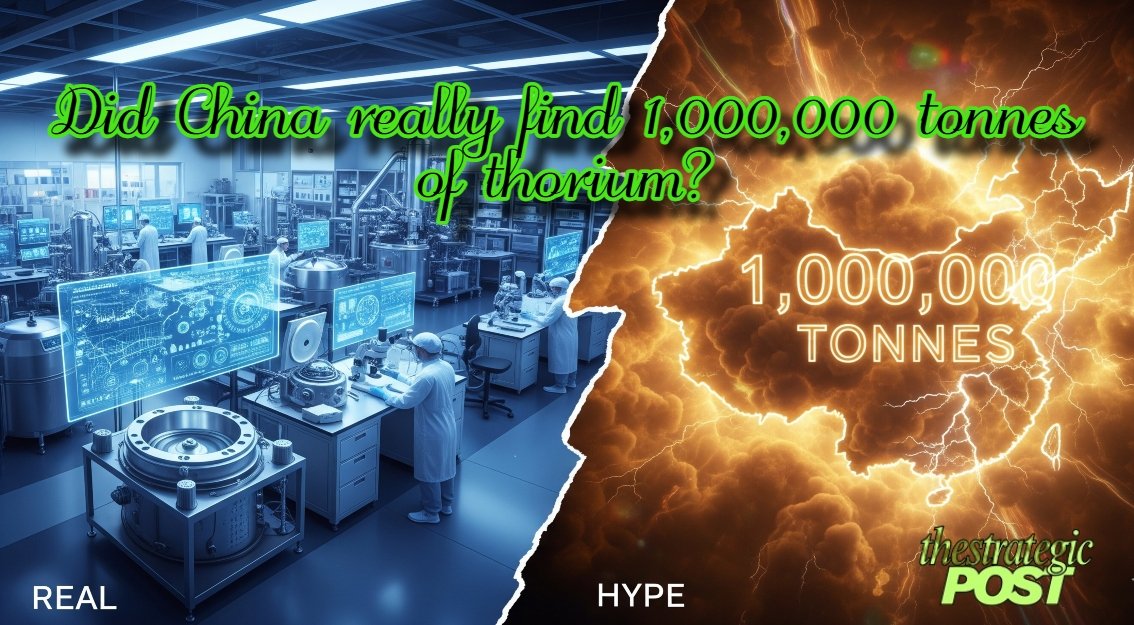Table of Contents
China’s “1 Million Tonnes of Thorium” Claim: What’s Real, What’s Hype?
Published: September 3, 2025
China’s 1 Million Tonnes of Thorium: A glowing graphic is making the rounds claiming China discovered over 1 million tonnes of thorium—enough to power Earth for thousands of years. It’s a bold line. But does it hold up when you pop the hood? Here’s a clear, no-nonsense breakdown for readers who want the facts without the fluff.
TL;DR
- Thorium is a promising nuclear fuel, but it isn’t plug-and-play.
- The viral “>1 million tonnes” figure is not confirmed by primary geological or nuclear agencies.
- Authoritative tallies still place China’s thorium resources far below the meme number, while global totals are in the ~6 million tonnes range.
- China is testing thorium-related molten-salt tech—but it’s experimental, not grid-scale yet.
What Even Is Thorium—and Why Do People Hype It?
- Thorium-232 isn’t fissile on its own; in certain reactors it breeds into U-233, which can then fission and release energy.
- Potential upsides often cited:
- Abundance in monazite sands
- Efficient fuel cycles in some designs (e.g., molten-salt)
- Lower long-lived transuranic waste vs. some uranium cycles
- Reality check: getting from ore to electricity requires a mature reactor ecosystem (designs, licensing, fuel fabrication/reprocessing, safety cases, supply chains).
About That “1,000,000 Tonnes” Number
- The viral claim ties to reports and posts referencing Bayan Obo, a giant rare-earth/iron mining complex in Inner Mongolia.
- Some media pieces talk about thorium in tailings and toss around “up to a million tonnes” if fully recovered.
- What’s missing: an official, peer-reviewed geological resource statement with classification (measured/indicated/inferred) and recovery economics. Until that appears, treat the number as promotional or speculative, not bankable.
What Authoritative Counts Say (Right Now)
- Global thorium resources: commonly cited around ~6 million tonnes (range varies by methodology).
- China’s share: public, reputable tallies have historically put it far lower than one million—often in the ~100k–300k tonnes ballpark depending on the source and year.
- Why the gaps?
- Different definitions (resources vs. reserves vs. monazite content assumptions)
- Sparse exploration because there’s been limited commercial demand for thorium
- Methodological variance across agencies and studies
Bottom line: Until a national geological survey or agency publishes a formal update, the “>1 million tonnes (China alone)” headline is not confirmed and should be read with caution.
“Power the Planet for Thousands of Years”—Can It?
Short answer: Too soon to say. Here’s why:
- Technology readiness
- China’s high-profile thorium-related molten-salt project in the Gobi (a small 2 MW-thermal prototype) is a testbed, not a commercial plant. Prototypes de-risk physics and materials; they don’t equal nationwide rollout.
- Fuel cycle complexity
- Thorium cycles need breeding to U-233, plus reprocessing and tight materials/corrosion control. That demands decades-long investment in facilities, people, and standards.
- Economics and regulation
- Even if ore is abundant, the delivered LCOE (levelized cost of electricity) depends on capital, supply chains, licensing, and learning curves we’re only just starting to climb.
Conclusion: Thorium could be a valuable option in a diversified low-carbon mix—but “planet-powering for millennia” is marketing talk, not today’s operating reality.
Why Thorium Still Matters (Without the Hype)
- Security of supply: Spreads fuel options beyond conventional uranium.
- R&D dividends: Molten-salt work improves materials science, online refueling concepts, passive safety.
- Waste benefits (potential): Certain thorium cycles may reduce transuranic inventories, easing long-term waste burdens—subject to design specifics.
What to Watch Next
- Official geological updates from recognized agencies detailing grade, tonnage, classification, recovery.
- Prototype results: uptime, corrosion data, breeding ratios, tritium handling—hard numbers from China’s molten-salt tests.
- Regulatory roadmaps for commercial thorium systems.
- Cost curves as pilot projects scale (supply chains, component vendors, standardized designs).
FAQs
Q: Is thorium “safer” than uranium?
A: Safety is system-level. Some thorium MSR designs promise passive safety features, but outcomes depend on engineering, operations, and regulation, not just the element.
Q: If it’s abundant, why isn’t everyone using thorium already?
A: Because commercial reactors and fuel cycles were built around uranium for 70+ years. Switching pathways requires new infrastructure and proof at scale.
Q: Could China leapfrog with thorium?
A: China moves fast on pilots, but commercial fleets need years of validation. Expect incremental steps, not overnight revolutions.
The Takeaway
The meme is catchy; the evidence is patchy. China has thorium and is experimenting with thorium-related molten-salt tech, but there’s no authoritative confirmation of a >1 million-tonne discovery—or of energy “for thousands of years.” Stay curious, stay skeptical, and watch the data.
Like clear, hype-free explainers? Bookmark TheStrategicPost for verified science and energy breakdowns that respect your time (and your brain cells).

